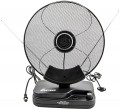VHF frequency range
The frequencies in the VHF range for which the antenna is designed. VHF includes frequencies from 30 to 300 MHz antennas with full coverage of this range are quite rare, but this is not required, because TV broadcast frequencies occupy only a part of VHF, and this part usually overlaps quite well.
Antenna sellers generally choose to sell models that are compatible with local frequencies. Therefore, in general, the frequency range is a rather specific parameter that the average user rarely needs — except when buying an antenna in another country. Also note that FM broadcasting in Europe and America uses the 87.5 – 108 MHz range, and antennas for such broadcasting (see "Signal Reception"), by definition, must cover these frequencies.
UHF frequency range
The frequencies of the UHF range for which the antenna is designed. UHF includes frequencies from 300 MHz to 3 GHz, however, frequencies above 900 MHz are practically not used in terrestrial television broadcasting, so TV antennas cover only the lower part of UHF. Also note that some manufacturers indicate a general range for their models, without dividing it into VHF (see above) and UHF; in such cases, this range is also indicated in this section.
Antenna sellers generally choose to sell models that are compatible with local frequencies. Therefore, in general, the frequency range is a rather specific parameter that the average user rarely needs — except when buying an antenna in another country.
Gain control
The ability
to control the built-in amplifier allows to stabilize the wave impedance between the antenna cable and the receiver. This prevents overloading, which in turn affects signal quality. Often, television antennas with a gain control option are equipped with their own 12 V power supply.
Cable length
The length of the connecting cable supplied with the antenna (often non-detachable). Quite a lot of models come with a cable right away, which eliminates the need to purchase it separately. And knowing the length of the cable, you can evaluate whether it is enough to reach the TV without additional cables.

